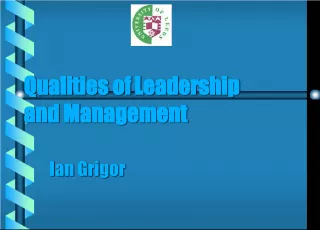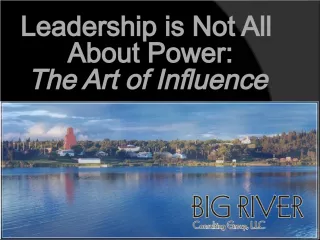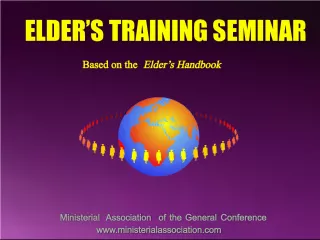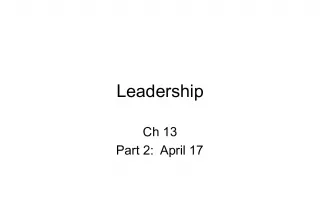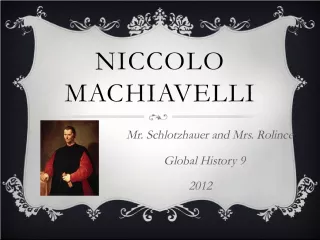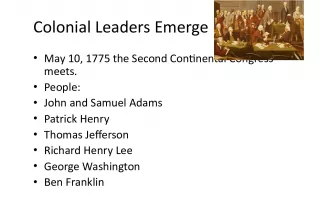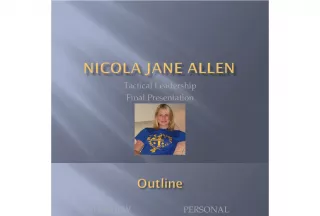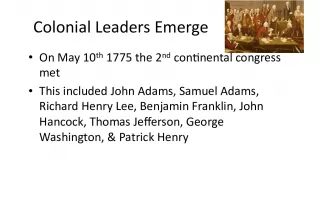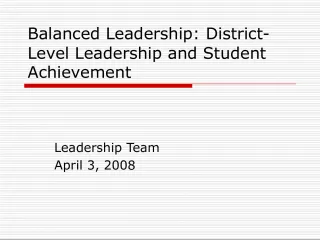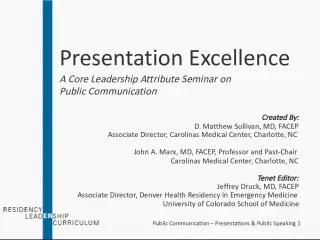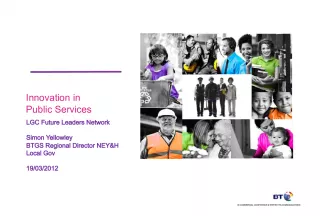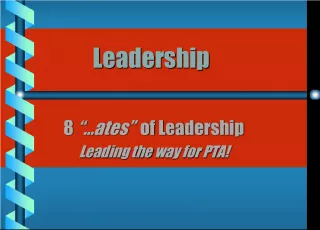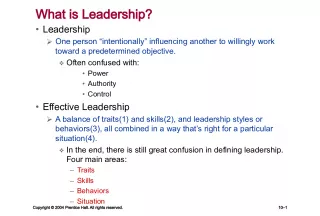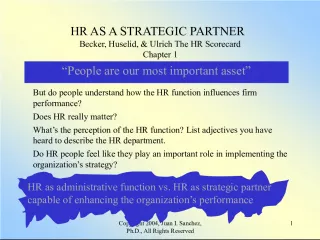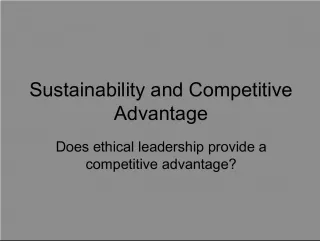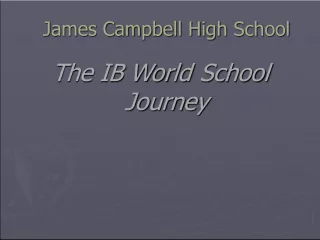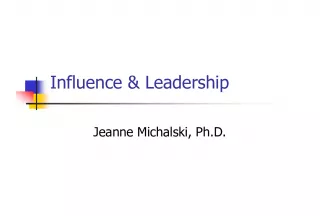Leadership: Understanding the Role of Managers as Leaders


This chapter discusses the definition of leaders and their role in management. It also covers early leadership theories, including leadership traits and behavioral leadership theories, and explains the dual nature of a leader's behavior.
- Uploaded on | 8 Views
-
 camillewong
camillewong
About Leadership: Understanding the Role of Managers as Leaders
PowerPoint presentation about 'Leadership: Understanding the Role of Managers as Leaders'. This presentation describes the topic on This chapter discusses the definition of leaders and their role in management. It also covers early leadership theories, including leadership traits and behavioral leadership theories, and explains the dual nature of a leader's behavior.. The key topics included in this slideshow are . Download this presentation absolutely free.
Presentation Transcript
1. ninth edition ninth edition STEPHEN P. ROBBINS STEPHEN P. ROBBINS PowerPoint Presentation by Charlie Cook The University of West Alabama PowerPoint Presentation by Charlie Cook The University of West Alabama MARY COULTER MARY COULTER © 2007 Prentice Hall, Inc. All rights reserved. © 2007 Prentice Hall, Inc. All rights reserved. Leadership Leadership Chapter 17 Chapter 17
2. © 2007 Prentice Hall, Inc. All rights reserved. 17–2 L E A R N I N G O U T L I N E Follow this Learning Outline as you read and study this chapter. L E A R N I N G O U T L I N E Follow this Learning Outline as you read and study this chapter. Who Are Leaders and What Is Leadership Who Are Leaders and What Is Leadership • Define leaders and leadership. • Define leaders and leadership. • Explain why managers should be leaders. • Explain why managers should be leaders. Early Leadership Theories Early Leadership Theories • Discuss what research has shown about leadership traits. • Discuss what research has shown about leadership traits. • Contrast the findings of the four behavioral leadership theories. • Contrast the findings of the four behavioral leadership theories. • Explain the dual nature of a leader’s behavior. • Explain the dual nature of a leader’s behavior.
3. © 2007 Prentice Hall, Inc. All rights reserved. 17–3 L E A R N I N G O U T L I N E (cont’d) Follow this Learning Outline as you read and study this chapter. L E A R N I N G O U T L I N E (cont’d) Follow this Learning Outline as you read and study this chapter. Contingency Theories of Leadership Contingency Theories of Leadership • Explain how Fiedler’s theory of leadership is a contingency model. • Explain how Fiedler’s theory of leadership is a contingency model. • Contrast situational leadership theory and the leader participation model. • Contrast situational leadership theory and the leader participation model. • Discuss how path-goal theory explains leadership. • Discuss how path-goal theory explains leadership. Contemporary Views on Leadership Contemporary Views on Leadership • Differentiate between transactional and transformational leaders. • Differentiate between transactional and transformational leaders. • Describe charismatic and visionary leadership. • Describe charismatic and visionary leadership. • Discuss what team leadership involves. • Discuss what team leadership involves.
4. © 2007 Prentice Hall, Inc. All rights reserved. 17–4 L E A R N I N G O U T L I N E (cont’d) Follow this Learning Outline as you read and study this chapter. L E A R N I N G O U T L I N E (cont’d) Follow this Learning Outline as you read and study this chapter. Leadership Issues in the Twenty-First Century Leadership Issues in the Twenty-First Century • Tell the five sources of a leader’s power. • Tell the five sources of a leader’s power. • Discuss the issues today’s leaders face. • Discuss the issues today’s leaders face. • Explain why leadership is sometimes irrelevant. • Explain why leadership is sometimes irrelevant.
5. © 2007 Prentice Hall, Inc. All rights reserved. 17–5 Leaders and Leadership Leaders and Leadership • Leader – Someone who can influence others and who has managerial authority • Leader – Someone who can influence others and who has managerial authority • Leadership – What leaders do; the process of influencing a group to achieve goals • Leadership – What leaders do; the process of influencing a group to achieve goals • Ideally, all managers should be leaders • Ideally, all managers should be leaders • Although groups may have informal leaders who emerge, those are not the leaders we’re studying • Although groups may have informal leaders who emerge, those are not the leaders we’re studying Leadership research has tried to answer: What is an effective leader? Leadership research has tried to answer: What is an effective leader?
6. © 2007 Prentice Hall, Inc. All rights reserved. 17–6 Early Leadership Theories Early Leadership Theories • Trait Theories (1920s-30s) • Trait Theories (1920s-30s) Research focused on identifying personal characteristics that differentiated leaders from nonleaders was unsuccessful. Research focused on identifying personal characteristics that differentiated leaders from nonleaders was unsuccessful. Later research on the leadership process identified seven traits associated with successful leadership: Later research on the leadership process identified seven traits associated with successful leadership: Drive, the desire to lead, honesty and integrity, self-confidence, intelligence, job-relevant knowledge, and extraversion. Drive, the desire to lead, honesty and integrity, self-confidence, intelligence, job-relevant knowledge, and extraversion.
7. © 2007 Prentice Hall, Inc. All rights reserved. 17–7 Exhibit 17–1 Seven Traits Associated with Leadership Exhibit 17–1 Seven Traits Associated with Leadership Source: S. A. Kirkpatrick and E. A. Locke, “Leadership: Do Traits Really Matter?” Academy of Management Executive, May 1991, pp. 48–60; T. A. Judge, J. E. Bono, R. llies, and M. W. Gerhardt, “Personality and Leadership: A Qualitative and Quantitative Review,” Journal of Applied Psychology, August 2002, pp. 765–780.
8. © 2007 Prentice Hall, Inc. All rights reserved. 17–8 Exhibit 17–2 Behavioral Theories of Leadership Exhibit 17–2 Behavioral Theories of Leadership
9. © 2007 Prentice Hall, Inc. All rights reserved. 17–9 Exhibit 17–2 (cont’d) Behavioral Theories of Leadership Exhibit 17–2 (cont’d) Behavioral Theories of Leadership
10. © 2007 Prentice Hall, Inc. All rights reserved. 17–10 Early Leadership Theories (cont’d) Early Leadership Theories (cont’d) • Behavioral Theories • Behavioral Theories University of Iowa Studies (Kurt Lewin) University of Iowa Studies (Kurt Lewin) Identified three leadership styles: Identified three leadership styles: – Autocratic style: centralized authority, low participation – Autocratic style: centralized authority, low participation – Democratic style: involvement, high participation, feedback – Democratic style: involvement, high participation, feedback – Laissez faire style: hands-off management – Laissez faire style: hands-off management Research findings: mixed results Research findings: mixed results – No specific style was consistently better for producing better performance – No specific style was consistently better for producing better performance – Employees were more satisfied under a democratic leader than an autocratic leader. – Employees were more satisfied under a democratic leader than an autocratic leader.
11. © 2007 Prentice Hall, Inc. All rights reserved. 17–11 Early Leadership Theories (cont’d) Early Leadership Theories (cont’d) • Behavioral Theories (cont’d) • Behavioral Theories (cont’d) Ohio State Studies Ohio State Studies Identified two dimensions of leader behavior Identified two dimensions of leader behavior – Initiating structure: the role of the leader in defining his or her role and the roles of group members – Initiating structure: the role of the leader in defining his or her role and the roles of group members – Consideration: the leader’s mutual trust and respect for group members’ ideas and feelings. – Consideration: the leader’s mutual trust and respect for group members’ ideas and feelings. Research findings: mixed results Research findings: mixed results – High-high leaders generally, but not always, achieved high group task performance and satisfaction. – High-high leaders generally, but not always, achieved high group task performance and satisfaction. – Evidence indicated that situational factors appeared to strongly influence leadership effectiveness. – Evidence indicated that situational factors appeared to strongly influence leadership effectiveness.
12. © 2007 Prentice Hall, Inc. All rights reserved. 17–12 Early Leadership Theories (cont’d) Early Leadership Theories (cont’d) • Behavioral Theories (cont’d) • Behavioral Theories (cont’d) University of Michigan Studies University of Michigan Studies Identified two dimensions of leader behavior Identified two dimensions of leader behavior – Employee oriented: emphasizing personal relationships – Employee oriented: emphasizing personal relationships – Production oriented: emphasizing task accomplishment – Production oriented: emphasizing task accomplishment Research findings: Research findings: – Leaders who are employee oriented are strongly associated with high group productivity and high job satisfaction. – Leaders who are employee oriented are strongly associated with high group productivity and high job satisfaction.
13. © 2007 Prentice Hall, Inc. All rights reserved. 17–13 The Managerial Grid The Managerial Grid • Managerial Grid • Managerial Grid Appraises leadership styles using two dimensions: Appraises leadership styles using two dimensions: Concern for people Concern for people Concern for production Concern for production Places managerial styles in five categories: Places managerial styles in five categories: Impoverished management Impoverished management Task management Task management Middle-of-the-road management Middle-of-the-road management Country club management Country club management Team management Team management
14. © 2007 Prentice Hall, Inc. All rights reserved. 17–14 Exhibit 17–3 The Managerial Grid Exhibit 17–3 The Managerial Grid Source: Reprinted by permission of Harvard Business Review . An exhibit from “Breakthrough in Organization Development” by Robert R. Blake, Jane S. Mouton, Louis B. Barnes, and Larry E. Greiner, November–December 1964, p. 136. Copyright © 1964 by the President and Fellows of Harvard College. All rights reserved.
15. © 2007 Prentice Hall, Inc. All rights reserved. 17–15 Contingency Theories of Leadership Contingency Theories of Leadership • The Fiedler Model (cont’d) • The Fiedler Model (cont’d) Proposes that effective group performance depends upon the proper match between the leader’s style of interacting with followers and the degree to which the situation allows the leader to control and influence. Proposes that effective group performance depends upon the proper match between the leader’s style of interacting with followers and the degree to which the situation allows the leader to control and influence. Assumptions: Assumptions: A certain leadership style should be most effective in different types of situations. A certain leadership style should be most effective in different types of situations. Leaders do not readily change leadership styles. Leaders do not readily change leadership styles. – Matching the leader to the situation or changing the situation to make it favorable to the leader is required. – Matching the leader to the situation or changing the situation to make it favorable to the leader is required.
16. © 2007 Prentice Hall, Inc. All rights reserved. 17–16 Contingency Theories… (cont’d) Contingency Theories… (cont’d) • The Fiedler Model (cont’d) • The Fiedler Model (cont’d) Least-preferred co-worker (LPC) questionnaire Least-preferred co-worker (LPC) questionnaire Determines leadership style by measuring responses to 18 pairs of contrasting adjectives. Determines leadership style by measuring responses to 18 pairs of contrasting adjectives. – High score: a relationship-oriented leadership style – High score: a relationship-oriented leadership style – Low score: a task-oriented leadership style – Low score: a task-oriented leadership style Situational factors in matching leader to the situation: Situational factors in matching leader to the situation: Leader-member relations Leader-member relations Task structure Task structure Position power Position power
17. © 2007 Prentice Hall, Inc. All rights reserved. 17–17 Exhibit 17–4 Findings of the Fiedler Model Exhibit 17–4 Findings of the Fiedler Model
18. © 2007 Prentice Hall, Inc. All rights reserved. 17–18 Contingency Theories… (cont’d) Contingency Theories… (cont’d) • Hersey and Blanchard’s Situational Leadership Theory (SLT) • Hersey and Blanchard’s Situational Leadership Theory (SLT) Argues that successful leadership is achieved by selecting the right leadership style which is contingent on the level of the followers’ readiness. Argues that successful leadership is achieved by selecting the right leadership style which is contingent on the level of the followers’ readiness. Acceptance: leadership effectiveness depends on whether followers accept or reject a leader. Acceptance: leadership effectiveness depends on whether followers accept or reject a leader. Readiness: the extent to which followers have the ability and willingness to accomplish a specific task. Readiness: the extent to which followers have the ability and willingness to accomplish a specific task. Leaders must relinquish control over and contact with followers as they become more competent. Leaders must relinquish control over and contact with followers as they become more competent.
19. © 2007 Prentice Hall, Inc. All rights reserved. 17–19 Contingency Theories… (cont’d) Contingency Theories… (cont’d) • Hersey and Blanchard’s Situational Leadership Theory (SLT) • Hersey and Blanchard’s Situational Leadership Theory (SLT) Creates four specific leadership styles incorporating Fiedler’s two leadership dimensions: Creates four specific leadership styles incorporating Fiedler’s two leadership dimensions: Telling: high task-low relationship leadership Telling: high task-low relationship leadership Selling: high task-high relationship leadership Selling: high task-high relationship leadership Participating: low task-high relationship leadership Participating: low task-high relationship leadership Delegating: low task-low relationship leadership Delegating: low task-low relationship leadership
20. © 2007 Prentice Hall, Inc. All rights reserved. 17–20 Contingency Theories… (cont’d) Contingency Theories… (cont’d) • Hersey and Blanchard’s Situational Leadership Theory (SLT) • Hersey and Blanchard’s Situational Leadership Theory (SLT) Posits four stages follower readiness: Posits four stages follower readiness: R1: followers are unable and unwilling R1: followers are unable and unwilling R2: followers are unable but willing R2: followers are unable but willing R3: followers are able but unwilling R3: followers are able but unwilling R4: followers are able and willing R4: followers are able and willing
21. © 2007 Prentice Hall, Inc. All rights reserved. 17–21 Contingency Theories… (cont’d) Contingency Theories… (cont’d) • Leader Participation Model (Vroom and Yetton) • Leader Participation Model (Vroom and Yetton) Posits that leader behavior must be adjusted to reflect the task structure —whether it is routine, nonroutine, or in between—based on a sequential set of rules (contingencies) for determining the form and amount of follower participation in decision making in a given situation. Posits that leader behavior must be adjusted to reflect the task structure —whether it is routine, nonroutine, or in between—based on a sequential set of rules (contingencies) for determining the form and amount of follower participation in decision making in a given situation.
22. © 2007 Prentice Hall, Inc. All rights reserved. 17–22 Contingency Theories… (cont’d) Contingency Theories… (cont’d) • Leader Participation Model Contingencies: • Leader Participation Model Contingencies: Decision significance Decision significance Importance of commitment Importance of commitment Leader expertise Leader expertise Likelihood of commitment Likelihood of commitment Group support Group support Group expertise Group expertise Team competence Team competence
23. © 2007 Prentice Hall, Inc. All rights reserved. 17–23 Exhibit 17–5 Leadership Styles in the Vroom Leader Participation Model Exhibit 17–5 Leadership Styles in the Vroom Leader Participation Model • Decide: Leader makes the decision alone and either announces or sells it to group. • Decide: Leader makes the decision alone and either announces or sells it to group. • Consult Individually: Leader presents the problem to group members individually, gets their suggestions, and then makes the decision. • Consult Individually: Leader presents the problem to group members individually, gets their suggestions, and then makes the decision. • Consult Group: Leader presents the problem to group members in a meeting, gets their suggestions, and then makes the decision. • Consult Group: Leader presents the problem to group members in a meeting, gets their suggestions, and then makes the decision. • Facilitate: Leader presents the problem to the group in a meeting and, acting as facilitator, defines the problem and the boundaries within which a decision must be made. • Facilitate: Leader presents the problem to the group in a meeting and, acting as facilitator, defines the problem and the boundaries within which a decision must be made. • Delegate: Leader permits the group to make the decision within prescribed limits. • Delegate: Leader permits the group to make the decision within prescribed limits. Source: Based on V. Vroom, “Leadership and the Decision-Making Process,” Organizational Dynamics , vol. 28, no. 4 (2000), p. 84.
24. © 2007 Prentice Hall, Inc. All rights reserved. 17–24 Exhibit 17–6 Time-Driven Model Exhibit 17–6 Time-Driven Model Source: Adapted from V. Vroom, “Leadership and the Decision-Making Process,” Organizational Dynamics , vol. 28, no. 4 (2000), p. 87.
25. © 2007 Prentice Hall, Inc. All rights reserved. 17–25 Contingency Theories… (cont’d) Contingency Theories… (cont’d) • Path-Goal Model • Path-Goal Model States that the leader’s job is to assist his or her followers in attaining their goals and to provide direction or support to ensure their goals are compatible with organizational goals. States that the leader’s job is to assist his or her followers in attaining their goals and to provide direction or support to ensure their goals are compatible with organizational goals. Leaders assume different leadership styles at different times depending on the situation: Leaders assume different leadership styles at different times depending on the situation: Directive leader Directive leader Supportive leader Supportive leader Participative leader Participative leader Achievement oriented leader Achievement oriented leader
26. © 2007 Prentice Hall, Inc. All rights reserved. 17–26 Exhibit 17–7 Path-Goal Theory Exhibit 17–7 Path-Goal Theory
27. © 2007 Prentice Hall, Inc. All rights reserved. 17–27 Contemporary Views on Leadership Contemporary Views on Leadership • Transactional Leadership • Transactional Leadership Leaders who guide or motivate their followers in the direction of established goals by clarifying role and task requirements. Leaders who guide or motivate their followers in the direction of established goals by clarifying role and task requirements. • Transformational Leadership • Transformational Leadership Leaders who inspire followers to transcend their own self-interests for the good of the organization by clarifying role and task requirements. Leaders who inspire followers to transcend their own self-interests for the good of the organization by clarifying role and task requirements. Leaders who also are capable of having a profound and extraordinary effect on their followers. Leaders who also are capable of having a profound and extraordinary effect on their followers.
28. © 2007 Prentice Hall, Inc. All rights reserved. 17–28 Contemporary Views…(cont’d) Contemporary Views…(cont’d) • Charismatic Leadership • Charismatic Leadership An enthusiastic, self-confident leader whose personality and actions influence people to behave in certain ways. An enthusiastic, self-confident leader whose personality and actions influence people to behave in certain ways. Characteristics of charismatic leaders: Characteristics of charismatic leaders: Have a vision. Have a vision. Are able to articulate the vision. Are able to articulate the vision. Are willing to take risks to achieve the vision. Are willing to take risks to achieve the vision. Are sensitive to the environment and follower needs. Are sensitive to the environment and follower needs. Exhibit behaviors that are out of the ordinary. Exhibit behaviors that are out of the ordinary.
29. © 2007 Prentice Hall, Inc. All rights reserved. 17–29 Contemporary Views…(cont’d) Contemporary Views…(cont’d) • Visionary Leadership • Visionary Leadership A leader who creates and articulates a realistic, credible, and attractive vision of the future that improves upon the present situation. A leader who creates and articulates a realistic, credible, and attractive vision of the future that improves upon the present situation. • Visionary leaders have the ability to: • Visionary leaders have the ability to: Explain the vision to others. Explain the vision to others. Express the vision not just verbally but through behavior. Express the vision not just verbally but through behavior. Extend or apply the vision to different leadership contexts. Extend or apply the vision to different leadership contexts.
30. © 2007 Prentice Hall, Inc. All rights reserved. 17–30 Contemporary Views…(cont’d) Contemporary Views…(cont’d) • Team Leadership Characteristics • Team Leadership Characteristics Having patience to share information Having patience to share information Being able to trust others and to give up authority Being able to trust others and to give up authority Understanding when to intervene Understanding when to intervene • Team Leader’s Job • Team Leader’s Job Managing the team’s external boundary Managing the team’s external boundary Facilitating the team process Facilitating the team process Coaching, facilitating, handling disciplinary problems, reviewing team and individual performance, training, and communication Coaching, facilitating, handling disciplinary problems, reviewing team and individual performance, training, and communication
31. © 2007 Prentice Hall, Inc. All rights reserved. 17–31 Exhibit 17–8 Specific Team Leadership Roles Exhibit 17–8 Specific Team Leadership Roles
32. © 2007 Prentice Hall, Inc. All rights reserved. 17–32 Leadership Issues in the 21 st Century Leadership Issues in the 21 st Century • Managing Power • Managing Power Legitimate power Legitimate power The power a leader has as a result of his or her position. The power a leader has as a result of his or her position. Coercive power Coercive power The power a leader has to punish or control. The power a leader has to punish or control. Reward power Reward power The power to give positive benefits or rewards. The power to give positive benefits or rewards. Expert power Expert power The influence a leader can exert as a result of his or her expertise, skills, or knowledge. The influence a leader can exert as a result of his or her expertise, skills, or knowledge. Referent power Referent power The power of a leader that arise because of a person’s desirable resources or admired personal traits. The power of a leader that arise because of a person’s desirable resources or admired personal traits.
33. © 2007 Prentice Hall, Inc. All rights reserved. 17–33 Developing Credibility and Trust Developing Credibility and Trust • Credibility (of a Leader) • Credibility (of a Leader) The assessment of a leader’s honesty, competence, and ability to inspire by his or her followers The assessment of a leader’s honesty, competence, and ability to inspire by his or her followers • Trust • Trust Is the belief of followers and others in the integrity, character, and ability of a leader. Is the belief of followers and others in the integrity, character, and ability of a leader. Dimensions of trust: integrity, competence, consistency, loyalty, and openness. Dimensions of trust: integrity, competence, consistency, loyalty, and openness. Is related to increases in job performance, organizational citizenship behaviors, job satisfaction, and organization commitment. Is related to increases in job performance, organizational citizenship behaviors, job satisfaction, and organization commitment.
34. © 2007 Prentice Hall, Inc. All rights reserved. 17–34 Exhibit 17–9 Suggestions for Building Trust Exhibit 17–9 Suggestions for Building Trust Practice openness. Practice openness. Be fair. Be fair. Speak your feelings. Speak your feelings. Tell the truth. Tell the truth. Show consistency. Show consistency. Fulfill your promises. Fulfill your promises. Maintain confidences. Maintain confidences. Demonstrate competence. Demonstrate competence.
35. © 2007 Prentice Hall, Inc. All rights reserved. 17–35 Providing Ethical Leadership Providing Ethical Leadership • Ethics are part of leadership when leaders attempt to: • Ethics are part of leadership when leaders attempt to: Foster moral virtue through changes in attitudes and behaviors. Foster moral virtue through changes in attitudes and behaviors. Use their charisma in socially constructive ways. Use their charisma in socially constructive ways. Promote ethical behavior by exhibiting their personal traits of honesty and integrity. Promote ethical behavior by exhibiting their personal traits of honesty and integrity. • Moral Leadership • Moral Leadership Involves addressing the means that a leader uses to achieve goals as well as the moral content of those goals. Involves addressing the means that a leader uses to achieve goals as well as the moral content of those goals.
36. © 2007 Prentice Hall, Inc. All rights reserved. 17–36 Empowering Employees Empowering Employees • Empowerment • Empowerment Involves increasing the decision-making discretion of workers such that teams can make key operating decisions in develop budgets, scheduling workloads, controlling inventories, and solving quality problems. Involves increasing the decision-making discretion of workers such that teams can make key operating decisions in develop budgets, scheduling workloads, controlling inventories, and solving quality problems. Why empower employees? Why empower employees? Quicker responses problems and faster decisions. Quicker responses problems and faster decisions. Addresses the problem of increased spans of control in relieving managers to work on other problems. Addresses the problem of increased spans of control in relieving managers to work on other problems.
37. © 2007 Prentice Hall, Inc. All rights reserved. 17–37 Cross-Cultural Leadership Cross-Cultural Leadership • Universal Elements of Effective Leadership • Universal Elements of Effective Leadership Vision Vision Foresight Foresight Providing encouragement Providing encouragement Trustworthiness Trustworthiness Dynamism Dynamism Positiveness Positiveness Proactiveness Proactiveness
38. © 2007 Prentice Hall, Inc. All rights reserved. 17–38 Exhibit 17–10 Selected Cross-Cultural Leadership Findings Exhibit 17–10 Selected Cross-Cultural Leadership Findings • Korean leaders are expected to be paternalistic toward employees. • Arab leaders who show kindness or generosity without being asked to do so are seen by other Arabs as weak. • Japanese leaders are expected to be humble and speak frequently. • Scandinavian and Dutch leaders who single out individuals with public praise are likely to embarrass, not energize, those individuals. • Effective leaders in Malaysia are expected to show compassion while using more of an autocratic than a participative style. • Effective German leaders are characterized by high performance orientation, low compassion, low self-protection, low team orientation, high autonomy, and high participation. Source: Based on J. C. Kennedy, “Leadership in Malaysia: Traditional Values, International Outlook,” Academy of Management Executive, August 2002, pp. 15–17; F.C. Brodbeck, M. Frese, and M. Javidan, “Leadership Made in Germany: Low on Compassion, High on Performance,” Academy of Management Executive, February 2002, pp. 16–29; M. F. Peterson and J. G. Hunt, “International Perspectives on International Leadership,” Leadership Quarterly, Fall 1997, pp. 203–31; R. J. House and R. N. Aditya, “The Social Scientific Study of Leadership: Quo Vadis?” Journal of Management, vol. 23, no. 3, (1997), p. 463; and R. J. House, “Leadership in the Twenty-First Century,” in A. Howard (ed.), The Changing Nature of Work (San Francisco: Jossey-Bass, 1995), p. 442.
39. © 2007 Prentice Hall, Inc. All rights reserved. 17–39 Gender Differences and Leadership Gender Differences and Leadership • Research Findings • Research Findings Males and females use different styles: Males and females use different styles: Women tend to adopt a more democratic or participative style unless in a male-dominated job. Women tend to adopt a more democratic or participative style unless in a male-dominated job. Women tend to use transformational leadership. Women tend to use transformational leadership. Men tend to use transactional leadership. Men tend to use transactional leadership.
40. © 2007 Prentice Hall, Inc. All rights reserved. 17–40 Exhibit 17–11 Where Female Managers Do Better: A Scorecard Exhibit 17–11 Where Female Managers Do Better: A Scorecard Source: R. Sharpe, “As Leaders, Women Rule,” BusinessWeek, November 20. 2000, p. 75.
41. © 2007 Prentice Hall, Inc. All rights reserved. 17–41 Basics of Leadership Basics of Leadership • Give people a reason to come to work. • Give people a reason to come to work. • Be loyal to the organization’s people • Be loyal to the organization’s people • Spend time with people who do the real work of the organization. • Spend time with people who do the real work of the organization. • Be more open and more candid about what business practices are acceptable and proper and how the unacceptable ones should be fixed. • Be more open and more candid about what business practices are acceptable and proper and how the unacceptable ones should be fixed.
42. © 2007 Prentice Hall, Inc. All rights reserved. 17–42 Leadership Can Be Irrelevant! Leadership Can Be Irrelevant! • Substitutes for Leadership • Substitutes for Leadership Follower characteristics Follower characteristics Experience, training, professional orientation, or the need for independence Experience, training, professional orientation, or the need for independence Job characteristics Job characteristics Routine, unambiguous, and satisfying jobs Routine, unambiguous, and satisfying jobs Organization characteristics Organization characteristics Explicit formalized goals, rigid rules and procedures, or cohesive work groups Explicit formalized goals, rigid rules and procedures, or cohesive work groups
43. © 2007 Prentice Hall, Inc. All rights reserved. 17–43 Terms to Know Terms to Know • leader • leader • leadership • leadership • behavioral theories • behavioral theories • autocratic style • autocratic style • democratic style • democratic style • laissez-faire style • laissez-faire style • initiating structure • initiating structure • consideration • consideration • high-high leader • high-high leader • managerial grid • managerial grid • Fiedler contingency model • Fiedler contingency model • least-preferred co-worker (LPC) questionnaire • least-preferred co-worker (LPC) questionnaire • leader-member relations • leader-member relations • task structure • task structure • position power • position power • situational leadership theory (SLT) • situational leadership theory (SLT) • readiness • readiness • leader participation model • leader participation model • path-goal theory • path-goal theory • transactional leaders • transactional leaders
44. © 2007 Prentice Hall, Inc. All rights reserved. 17–44 Terms to Know (cont’d) Terms to Know (cont’d) • transformational leaders • transformational leaders • charismatic leader • charismatic leader • visionary leadership • visionary leadership • legitimate power • legitimate power • coercive power • coercive power • reward power • reward power • expert power • expert power • referent power • referent power • credibility • credibility • trust • trust • empowerment • empowerment
